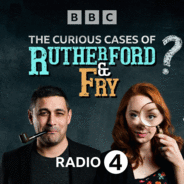Rutherford and Fry are back in the business of solving your science queries and rooting out the quirks and conundrums of everything that is science!

Comedy & KabarettWissenschaft & Technik
Curious Cases Folgen
Hannah Fry and Dara O Briain tackle listeners' conundrums with the power of science!
Folgen von Curious Cases
136 Folgen
-
Folge vom 01.12.2020We’re back!
-
Folge vom 14.07.2020The Space BurritoIs there a point in space where the Sun could heat a burrito perfectly? asks Will. The doctors tackle this and a plethora of other conundrums from the Curious Cases inbox.Featuring expert answers from: Astrophysicist Samaya Nissanke Cosmologist Andrew Pontzen Cognitive neuroscientist Sophie Scott Presenters: Hannah Fry & Adam RutherfordProducer: Jen WhyntieFirst broadcast on BBC Radio 4 in July 2020.
-
Folge vom 07.07.2020The Zedonk Problem‘Today I learnt that tigons and ligers are what you get when lions and tigers interbreed?!’ surprised listener Jamz G tells the doctors. ‘What determines whether species can interbreed?’ Geneticist Aoife McLysaght studies molecular evolution. She explains the modern definition of a species, built on ideas from Aristotle, Linnaeus and Darwin: a species is a group of organisms capable of interbreeding to produce fertile offspring. Hybrids – such as ligons and tigers – are usually infertile, because their common ancestors long ago diverged into the lions and tigers we know today. However, this definition isn’t absolute, and there are many ways a new species can be formed.Hybrids also offer rich study subjects for scientists. Mathematical biologist Kit Yates discusses why he’s been reading research papers about hebras and zorses (horse x zebra) as their patterns offer insights into how cells spread and develop into organisms, building on a prediction made by codebreaking mathematician Alan Turing.And it turns out that these hybrids are even more intriguing. As speciation and evolution expert Joana Meier explains, hybrids are not always infertile. Hybridisation can lead to successful new species arising, such as in Lake Victoria’s cichlid fish, who it seems have been having a wild evolutionary party for the last 15,000 years. And the picture gets even murkier when we discover that modern genetics reveals our human ancestors successfully mated with Neanderthals. Presenters: Hannah Fry & Adam RutherfordProducer: Jen WhyntieFirst broadcast on BBC Radio 4 in July 2020.
-
Folge vom 30.06.2020The End of EverythingEveryone knows about the Big Bang being the beginning of the universe and time - but when and how is it going to end? ask brothers Raffie and Xe from Rome. For this series, with lockdown learning in mind, Drs Rutherford and Fry are investigating scientific mysteries for students of all ages. The doctors sift science from philosophy to find out.Cosmologist Jo Dunkley studies the origins and evolution of the universe. She explains how astrophysical ideas and techniques have evolved to tell us what we now know about our galaxy and far beyond, from the elegant parallax technique to standard candles. This particular distance measure, which uses stars of a known brightness to work out how far away other objects in the universe are, was discovered by American astronomer Henrietta Swan Leavitt in 1912, who worked at the Harvard University as one of several “computers” – women who processed and calculated data and made significant contributions to astronomy.Curious Cases’ universal guru Andrew Pontzen puts this into context. Because the universe is so enormous, it turns out that these measurements are just the first steps on the cosmic distance ladder – a suite of tools that astrophysicists use to determine distances to celestial objects. Scientists know that objects are moving away from us because the wavelengths of light from them get stretched and appear redder in our telescopes – the so-called red shift effect. But having a handle on the distances to and between those objects allows cosmologists to monitor what’s happening to them over time. And it turns out that not only are they getting further apart, indicating that the universe is expanding, but that this process is accelerating. So what might happen in the end? Expansion and then collapse – a big crunch? Expansion into the void – a big freeze, or a big rip? Or what if there is more than one universe – might a new one bubble up with totally different laws of physics that would cause our own to cease existing? It turns out that when dealing with predictions for something involving infinite space and time, the possibilities are largely limited by human imagination alone. Ideas are where science starts, but experiments are required to build evidence confirming or rejecting them as fact. The doctors discuss how gravitational wave detectors and quantum computers might one day provide this.Presenters: Hannah Fry & Adam Rutherford Producer: Jen WhyntieFirst broadcast on BBC Radio 4 in June 2020.
